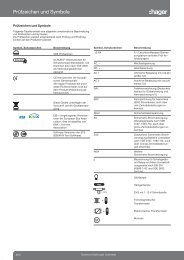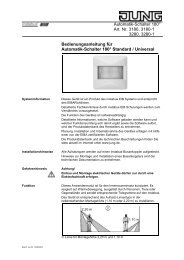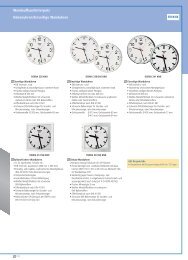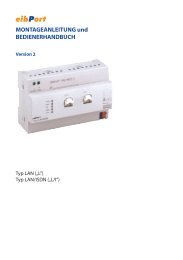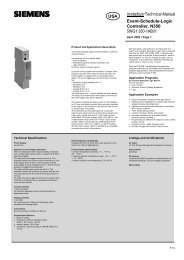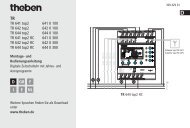Create successful ePaper yourself
Turn your PDF publications into a flip-book with our unique Google optimized e-Paper software.
4.2.4.3.3 Administrator settings<br />
Order-No. 7574 00 1X<br />
picture 19: Administrator settings<br />
Software "...590101"<br />
Functional description<br />
In the third area of the Service page, the administrator of the panel can make various configurations.<br />
The following functions can be configured...<br />
- Default setting: here the panel can be reset to the default settings. For security reasons,<br />
there is an explicit query. The following data is then reset:<br />
RSS newsfeed and e-mail configuration data, recordings by the datalogger, light scenes<br />
are deleted (names and values), timer switch data is deleted, the selected colour scheme<br />
and basic brightness are reset, fault messages are deleted, calibration data is reset to the<br />
standard setting. The function is noted in the history memory. Project data is maintained<br />
when the default settings are applied.<br />
- Passwords: the passwords for the various password levels can be changed here (see<br />
chapter 4.2.4.3.4. Passwords).<br />
- Version: detailed information on the hardware and software of the panel is displayed here.<br />
- IP settings: the IP communication parameters of the panel can be set here. If necessary,<br />
these settings must be agreed with the local network support (network administrator) (see<br />
chapter 4.2.4.3.5. IP settings).<br />
- History: a list of internal device operations is displayed here. An operation entered in the<br />
history list could be a device reset or a programming operation. Various error states are<br />
logged in the history. A distinction is primarily made between two types of list entries. On<br />
the one hand, there are entries affecting internal device functions and the USB and KNX/<br />
EIB functions (see Table 3), On the other, there may be list entries describing operations<br />
for IP communication and functionalities. With the IP operations, a distinction is made as to<br />
whether the event to be logged affects general communication via the Ethernet interface<br />
(see Table 4 & 5.x) or the RSS newsfeeds (see Table 6). IP operations are logged in the<br />
history as follows...<br />
- IP E: ID for operations which generally affect IP communication<br />
- IP RSS Feed: < RSS error code> for operations affecting the RSS<br />
newsfeeds<br />
The Tables 4, 5.x & 6 contain a description of the appropriate IP error codes and ID codes.<br />
Page 70 of 222






